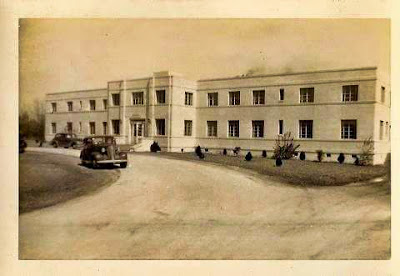The scars of the First World War and the Great Depression faded quickly in Hemingway, according to Dess G. Creel in a 1949 Florence Morning News article. The town's population had grown from approximately 500 in 1939 to around 1,200 ten years later. The post office served more than 8,000 people through four rural routes with 810 boxes and two star routes.
When Hemingway was founded, there was only one store in town, that of the W.C. Hemingway Company. By 1949, however, Creel noted, "virtually every business is represented."
Between 1948 and 1949, more than 100 homes were built in Hemingway, and more were under construction when Mrs. Creel wrote her article in July 1949. Three 40,000-square-foot tobacco warehouses had just been completed as Hemingway was set to re-enter the Pee Dee Tobacco Market, from which it had withdrawn in 1926, a result of financial crises in the aftermath of World War I.
In 1949, Hemingway was justly proud of its Johnson Memorial Hospital, built by Dr. Allen H. Johnson in memory of his father, Dr. Liston Bass Johnson.
In 1948, F.M. Shuford had installed a modern telephone service in Hemingway for the Pee Dee Telephone Company. Carolina Power & Light furnished electricity, with Santee Electric Cooperative serving a small portion of the city limits on South Main Street. The city water supply came from an artesian well, which was to be supplemented by a second well being dug in 1949 by the Layne-Atlantic Company of Savannah. GA.
Local organizations in 1949 were the Junior Chamber of Commerce, Dr. Vernon L. Bauer, president; The American Legion, J.O. Lewis, post commander; the Civitan Club, J.E. Doster, president; the National Guard, Julian Brown, captain; the Masonic Lodge, Percy B. Lawrimore, worshipful master; the Order of the Eastern Star, Mrs. B.J. Chandler, worthy matron, the Hemingway Garden Club and a number of social clubs and organizations.
The town had two doctors and two lawyers in 1949.
Dess Creel wrote, "The largest veteran's school in the state is located here. Dr. H.N. Merritt is supervisor. The first class of 15 graduated this spring. On the school campus is a lighted athletic field which was made possible by sponsorship of the Junior Chamber of Commerce and financial aid from many business firms and organizations." There was also a cannery located on the school campus which was operated under the supervision of Dr. Merritt and Mrs. W.B. Galloway, who was home economics supervisor.
A modern electric gin was owned and operated by R.L. Cox while Jack Cockfield owned and operated a refrigeration and locker plant/grocery store combination. Dr. T.A. Curtis owned an ice cream factory called Dixie Dairies. E.M. Joye's livestock market held auction sales at 2:30 p.m. every Thursday, which had encouraged the farmers of the area to raise livestock, providing additional income throughout the year. R.H. Southern operated a flour and grits mill, and O.G. Huggins, K.N. Huggins. O.G. Huggins, Jr., and A.T. Huggins & Sons operated lumber mills.
The Seaboard railway furnished a receiving and forwarding station for the 20,000 bushels of cucumbers produced annually in the area for a pickling plant in New York.
Several large department stores were located in Hemingway, including Ruffins Department Store, R.C. Ratcliffe, Foresters, H.J. Burch and the Tomlinson Corporation. The hotel and bus station lunchroom were owned and operated by Mr. and Mrs. J.D. Chinnes.
Dess Creel noted that the town was well-supplied by grocery stores. She wrote, "One of the largest grocery stores has the distinction of being managed by a lady who did such a splendid job during the war when male talent was so scarce that the owners will not release her now."
In addition the town had two drug stores, two jewelry stores, three electric supply stores, a Western Auto, two hardware stores, two dry cleaners, three automobile dealers, three barbershops and two beauty salons, as well as shoe stores, feed and seed stores, fertilizer distributors and many service stations.
In 1949, S.J. Haselden, a World War II veteran, was mayor, with A.C. Haselden, J.L. McAlister, D.T. Fenters, Jr., and Bernard Davis on town council. W.E. Cox was chief of police and C.D. Huggins and sons were in charge of the water department.
Dess Creel writes, "The city fire department is one of the best with 21 volunteer members, including one Negro member. The city fire equipment includes a new fire truck and water hydrants on every block." F. Edwin Huggins was fire chief in 1949.
The tombstone of Yetta and Joseph Ellis
Mrs. Creel also noted that while many small Southern towns attracted a number of Jewish merchants, Hemingway's only merchant of the Jewish faith was "Joseph Ellis, who with his sister, the late Miss Yetta Ellis, came here from Baltimore early in the history of the town and opened a dry goods store. By his loyalty, interest and enterprise, he ranks with the natives."






No comments:
Post a Comment